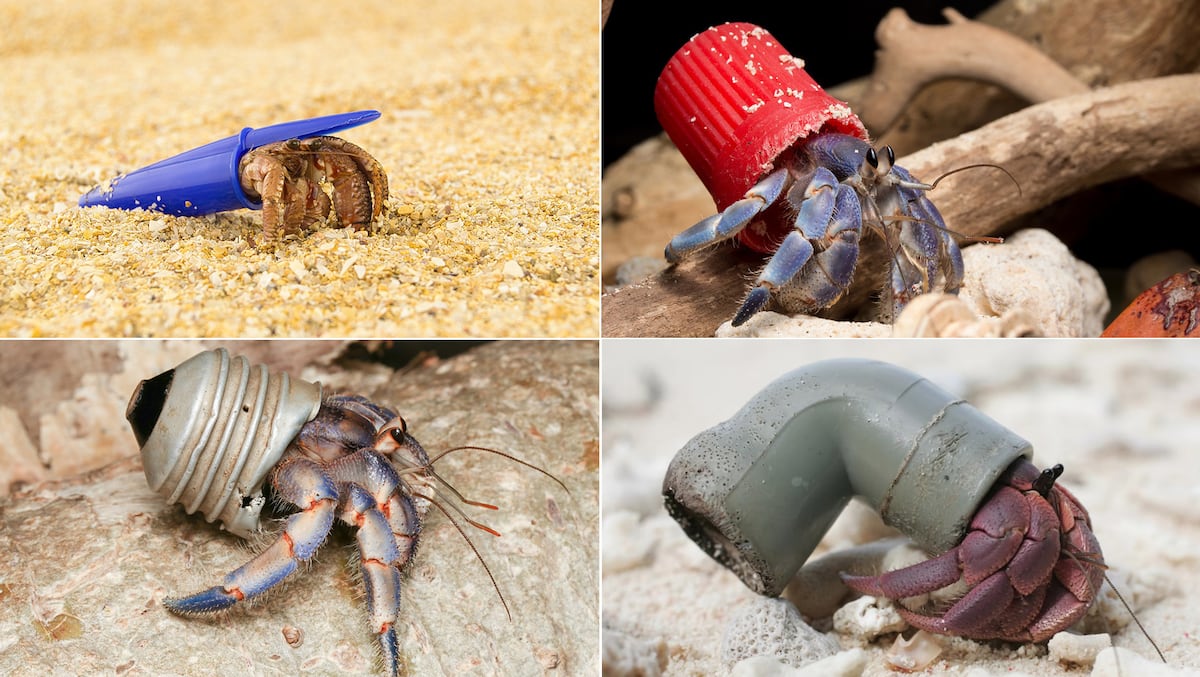Pellets, plastics, microplastics and all types of waste flood the planet's beaches;
and for hermit crabs these materials are now a home.
Some videos of these animals using caps, light bulbs and plastic cups as shells have been circulating online for some time.
This is not an isolated case, nor something that happens in some specific places, but rather it is a behavior that occurs on a global scale.
This is confirmed by new research published in
Science of The Total Environment
, which
alert that most terrestrial species of hermit crabs around the planet already use garbage as shells.
For the study, Polish biologists analyzed scientific literature and videos available online, in which they found 386 examples of these crustaceans wrapped in garbage.
The videos showed specimens of 10 of the 16 species of hermit crab that exist on Earth and were found throughout the tropics, from Africa to Central America.
85% of them used plastic scraps and the rest used other materials, such as metal and glass.
“We have confirmed, for the first time, that the use of artificial materials by hermit crabs is a behavior that occurs on a global scale,” explains biologist Zuzanna Jagiello, author of the study.
Researchers attribute this trend to the fact that debris is easier to find on coasts than shells, and provides better camouflage for crabs.
Furthermore, in their analysis, they also include other factors such as weight and sexual attractiveness: the first, because carrying a shell that is heavier represents a significant energy expenditure;
and second, because the color and smell of plastic can help them attract a partner.
A previous 2021 study found that crabs are attracted to a chemical emitted by plastics.
More information
The origin of a fatal attraction: why mosquitoes and moths flutter around light bulbs
Not everything is advantages.
In 2019 it was revealed that 414 million pieces of garbage had washed up on the shores of the Cocos Islands, a remote Australian territory in the Indian Ocean.
A group of scientists investigated the impact of waste on hermit crabs in the area and found that more than half a million of them had gotten inside objects where they became trapped and died.
The effects of replacing their shell houses with plastic ones on crabs are still unclear, but researchers believe it can lead to dangerous situations, as has been seen in turtles with straws in their noses or in sperm whales carrying kilos of garbage in the stomach.
However, although she confessed to feeling “heartbroken” to see that they live among the garbage, Jagiello believes that it is necessary to understand the fact that “it is a different era and animals are making use of what they have at their disposal.”
The intelligence of hermit crabs
Getting a house is not an easy thing.
The life of hermits is full of difficult decisions that require developed cognitive abilities.
Although the brains of hermits have only just begun to be studied, early studies have found differences with other crabs.
For example, the areas responsible for spatial perception and exploration are more developed;
and having a good memory allows them to remember the characteristics of the shells, which saves them work later.
Unlike most crabs, which have a naturally calcified abdomen, hermits are born with soft bodies.
They inhabit shells because it provides them with protection—from predators, from water currents if they are marine, and from desiccation if they are terrestrial—so it is crucial for every hermit to select the best one possible, but how do they do it?
When they spot an interesting shell, they first evaluate it with their eyes to obtain information about the type of shell, size, and color.
Then, with paws and tweezers, they explore the inside and outside to make sure it is an appropriate size.
They look for larger and larger shells to shed as they grow.
In addition, these crabs practice exchange chains.
If a hermit comes across a shell that is too big, he rejects it, but does not go far.
Other crabs may also find the conch and do the same.
By the time one big enough for the shell arrives, those waiting are sorted by size.
If the first crab makes the change, the chain reaction begins and everyone gets a better shell.
With this behavior, the crabs seem to predict that new shells will be available and organize themselves so that everyone can move house.
It has been shown that they do indeed remember the shells they have previously inhabited or inspected.
Shawn Miller is a photographer who has participated in the research by capturing images of crustaceans wrapped in debris.
In a video he shows how one of them moves from a piece of plastic to a shell that they selected for him.
Miller assures that “hermit crabs do not prefer to live in plastic, they are simply using it until they find a better option.”
While available shells have been decreasing, plastic continues to increase.
Mollusks are the architects of seashells, which they make with calcium carbonate from seawater;
and there are fewer and fewer, due to fishing pressure, rising ocean temperatures and water pollution.
Greenpeace estimates that in 2020 the rate of plastic production had increased by 900% compared to 1980, reaching more than 500 million tons per year.
In Spain, 50% of plastics reach landfills without being recycled.
The authors suggest that the images of crustaceans with garbage homes contain “a lesson for humans”: like hermit crabs, we need to reuse more plastic instead of throwing it away.
You can follow
MATERIA
on
,
X
and
, or sign up here to receive
our weekly newsletter
.
Subscribe to continue reading
Read without limits
Keep reading
I am already a subscriber
_

